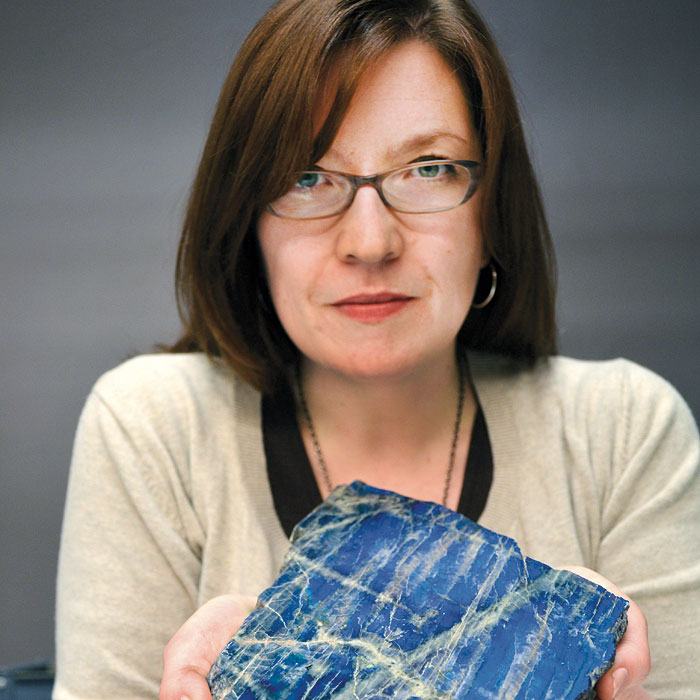In honor of its illustrious bicentennial year, the Academy of Natural Sciences of Drexel University has kicked off a yearlong celebration with commemorative events, programs and exhibits for all ages. But while a bicentennial typically suggests a look to the past, the Academy plans to give equal weight to its relevance in the world of science today—and also where it’s headed in its third century.
This bicentennial year pays tribute both to the Academy’s discoveries over the past two centuries and its ongoing efforts to answer today’s questions about our natural world. The institution’s scientists, and its educators and administration, are on a mission to tell the Academy’s story and invite the public to be a part of its next chapter.
With preparations for the big celebration under way this winter, Drexel Magazine met with three Academy “storytellers” to discuss the ways they’ll be working to the share the remarkable story of this remarkable institution—an institution that is fully part of the Drexel family.
THE PAST
Robert McCracken Peck, Academy Historian and Senior Fellow
People have always told Bob Peck that he was born into the wrong century.
A polished, well-spoken gentleman with a fiery passion for books, literature and history, Peck carries the demeanor of a 19th century scholar. Perhaps this is what makes him the perfect storyteller for the Academy’s first two centuries.
Three years ago, with the Academy’s bicentennial looming, Peck took on one of the grandest research projects of his life—authoring a complete history of the Academy. Peck knew there would never be a more perfect time to tell this story than the Academy’s 200th anniversary.
Along with colleague and historical biographer Patricia Tyson Stroud, who, like Peck, has a decades-long connection to the Academy, he authored A Glorious Enterprise: The Academy of Natural Sciences of Philadelphia and the Making of American Science, a 464-page history of the institution. The book is the result of countless hours spent in libraries and archives, where Peck and Stroud sorted through a flurry of materials documenting the evolution of the Academy and its contributions to science in America.
The book examines the people of the Academy—the individuals who helped it become a leading light in natural sciences research— instead of providing a chronological history. This approach was intentional, Peck says.
“It’s often said that history is all about biography—that was the approach we wanted to take,” Peck says. “It’s a very lively, personal story about the interesting characters of the Academy and the work they did here to advance science.”
A Glorious Enterprise, affectionately described as a “family history” of the Academy, profiles important Academy figures associated with the museum such as William Bartram, Thomas Jefferson, Alexander Wilson, John James Audubon, Ernest Hemingway (who collected fish for the Academy), and the real James Bond (the Academy ornithologist whose name was borrowed by British author Ian Fleming for his 007 spy thrillers). Others whose contributions are explored include paleontologists Joseph Leidy and Edward Drinker Cope and limnologist Ruth Patrick.
History has its share of villains and the Academy is no exception—the book touches on the few bad apples who used the Academy and its reputation for their own gain. Fortunately, these “charlatans and scoundrels,” as Peck calls them, never did any permanent damage.
The specimens in the Academy’s collection also have their own story to tell. The book is filled with stunning images of minerals, birds, fish, mammals, plants and other specimens from the collection, all captured by internationally acclaimed photographer Rosamond Purcell.
“We wanted items from the collection to be as much a part of the story as the people,” Peck says.
Much has changed since the Academy’s founding in 1812, Peck says. Still, other things have remained the same.
“The passion and love of natural history that you see in everyone associated with the Academy—that has lasted,” he says. “Few people who work at the Academy consider it a job. For many of us, it stands next to friends and family as the focus of our lives.”
THE PRESENT
Jennifer Sontchi, Acting Director of Exhibits
If the Academy’s exhibits had a voice, Jennifer Sontchi would want them to say just one thing: “Come closer.”
As acting director of exhibits, Sontchi is charged with the task of choosing for display items from the Academy’s massive collection of 17 million biological specimens. More importantly, she’s responsible for telling the story of why these specimens are so important, why the Academy has so many and why they must be protected so dutifully.
For the bicentennial, Sontchi was given an 80-foot wall in which to display some of the gems of the collection in a new exhibit, “The Academy at 200: The Nature of Discovery.”
“We selected classic natural history specimens that people would recognize like skulls and shark teeth and famous historical specimens like Thomas Jefferson’s personal fossil collection,” Sontchi says. “But we didn’t want to shy away from the more mysterious items—the ones you might not recognize unless you look more closely.”
Sontchi uses the exhibit to explain that these beautiful and strange specimens are more than just eye candy.
“The Academy is so well known for having all of these cool things, but we’re also an active research institution. We use our collections every day in our work,” she says. The exhibit illustrates the life and purpose of a specimen, from its collection in the field, to identification, to curation into the collection and, finally, its use in scientific research and public education. Far from dusty relics, Sontchi says, “these collections are relevant to the lives of each and every one of us every day.”
The exhibit also invites visitors on five “immersive” experiences to illustrate what life is like “in the field” for Academy scientists.
Scientific expedition is also highlighted in another new exhibit at the Academy: “Secrets of the Diorama.” Here, Sontchi and her team of exhibit developers offer a behind-the-scenes look at how and why the Academy’s famous natural history dioramas were made.
The Academy’s dioramas are a unique combination of science and art—all 37 dioramas are the result of scientific expeditions on the part of Academy scientists and other natural history explorers with ties to the institution.
“We want people to know that nothing in these dioramas was invented,” she says. “That vista that you’re looking at is a direct reproduction of what the scientist saw.”
These three-dimensional illusions were installed at the Academy in the 1920s through the 1960s. “Secrets of the Diorama” details the creation of the diorama’s foreground, background and animals, which, contrary to popular belief, are not actually stuffed. Instead, the animal skin is stretched over a form custom made for each animal. “Secrets” is the first exhibit to fully explain all three components of the diorama.
Will knowing the secrets behind a lifelike diorama change how the visitors see them? “Absolutely. It makes for a richer experience if you understand the scientific work and the painstaking artistry behind them,” Sontchi says.
THE FUTURE
Sara Hertz, Vice President for Strategic Initiatives
Long before the clock struck midnight on December 31, 2011, marking the start of 2012, Sara Hertz was already thinking about 2013. For her, the Academy’s bicentennial marks the end of an era—and the start of an exciting future.
“In celebrating this occasion, we certainly want to be respectful of our history, but I don’t want us to be stuck in time. We really want to define the Academy’s future,” she says.
One theme that will continue to expand in the coming years at the Academy is the institution’s ardent commitment to sustainability, she says. With the establishment of the Center for Environmental Policy (CEP) in 2009, the Academy has been solidifying its reputation as a leader in sustainability and a destination for people seeking a forum for critical environmental topics. “People will see this year more than ever our commitment to sustainability, not only in our own operations, but in being the place where people can come and learn about important issues around sustainability and the environment,” Hertz says.
A special town square series designed for the bicentennial will examine four important topics, including climate change and energy use, food policy, water quality and green building and urban design, according to CEP Director Roland Wall. “The Academy is moving into the future,” he says. “These critical environmental issues affect the whole planet and they are in our focus.”
Already the Academy has made a big move in defining its future self—its affiliation with Drexel University, Hertz says.
“The Academy’s affiliation with Drexel is a remarkably happy coincidence. It puts us in an incredibly strong position to enter into our third century,” Hertz says. “I’m looking forward to seeing the power of the dinosaur and the dragon.”
Hertz is heavy into the planning for the Academy’s grand Third Century Gala, scheduled for March 2013, which will serve as the finale to the bicentennial year. It will be one of the Academy’s largest fundraisers to date and the official start of its next century. The Academy will host another fundraiser this fall, called Cuisine From the Collections, where guests will enjoy delicacies inspired by, but not necessarily made from, the Academy’s collections.
Despite this whirlwind of bicentennial events, exhibits and programming, Hertz and her colleagues all work toward a common goal: share the Academy’s past, present and future with as many people as possible.
“We’re part of the fabric of this city. More and more people are realizing that we’re relevant, dynamic and fun. They know that we have great programs and amazing art and that we have a real impact, regionally and beyond. We intend to keep that going.”




